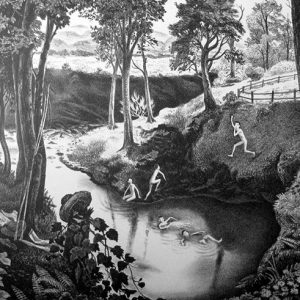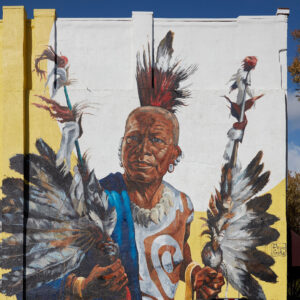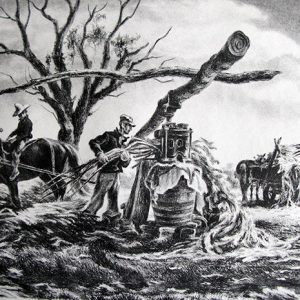calsfoundation@cals.org
Charles Banks Wilson (1918–2013)
Charles Banks Wilson was a world-renowned lithographer, painter, teacher, historian, and book illustrator whose art has been exhibited throughout the United States and the world. He is best known for his drawings and paintings of Native American life as well as for his vivid representations of the people, events, and landscapes of the Ozark Mountains, his primary artistic inspiration.
Charles Banks Wilson was born on August 6, 1918, in Springdale (Washington County). His father, Charles Bertram Wilson, was serving in France during World War I when Wilson was born. His mother, Bertha Juanita Banks Wilson, was a public school teacher. Both parents had lived in Springdale but did not meet until each had moved eighty-five miles westward in the Ozark foothills to Miami, Oklahoma. Wilson had one brother.
Wilson displayed an early interest in art and pursued drawing and painting from around age four. When Wilson was thirteen years old, he met and sketched Will Rogers, the American cowboy humorist and social commentator, while Rogers visited Miami. It was the first of many times Wilson was to draw and paint Rogers.
Following graduation from high school in 1936, Wilson enrolled at the Art Institute of Chicago. He was there three years before briefly moving to New York for work as a cartoonist. Unhappy with the work, he returned to Chicago and completed another year at the art institute. While studying in Chicago, Wilson began creating lithographs (prints made from drawings on stone using ink-repellent grease crayons). During his career, he produced more than 200 stones.
In 1941, Wilson married Edna McKibben, a Native American of Quapaw, Eastern Shawnee, and Peoria lineage. They had two children.
Encouraged and supported by artist Aaron Bohrod and recommended by artist Thomas Hart Benton, Wilson returned to New York and began work with Associated American Artists. He completed four lithographs for the association. Wilson found inspiration in his childhood memories of the Ozarks and often used Arkansas themes for his prints. While in New York, he completed one of his most famous pieces, The Swimmin’ Hole, depicting boys at play on a hot summer day. The print, published in 1942 by the association, became one of Wilson’s most popular. The Metropolitan Museum of Art distributed prints of the piece to World War II troops in training camps throughout the country. Louis Untermeyer, the American poet, critic, and editor, described it as “America’s best loved print.” Wilson later reproduced the lithograph and renamed it Ozark Summer. Another of Wilson’s well-known works, Sorghum Mill, portrayed an old mill he found south of Bentonville (Benton County) near his birthplace. In 1942, Wilson exhibited in the Artist of Victory show at the Metropolitan Museum of Art. He produced other war-related lithographs during this period, including Freedom’s Warrior (1943).
During World War II, Wilson returned to Oklahoma and established a studio in Miami above his father’s store. In 1945, Wilson founded the art department at Northeastern Oklahoma A&M College in Miami, which he chaired for fifteen years.
Wilson won the Joseph Pete Pinnell Award at the Library of Congress in 1955. That same year, he completed his first mural commission, from John D. Rockefeller, for The Trapper’s Bride at Rockefeller’s Tetons Lodge in Jackson Hole, Wyoming. In 1957, Wilson painted a portrait of Thomas Gilcrease—an Oklahoma oilman, art collector, and philanthropist—for the Thomas Gilcrease Museum in Tulsa, Oklahoma.
Wilson retired from teaching in 1960 to devote more time to studio work. He spent that summer with Thomas Hart Benton traveling and sketching on the Santa Fe Trail. Soon afterward, at the request of Benton’s wife, Rita, Wilson painted Benton’s portrait. The portrait was unveiled by former president Harry S. Truman in Benton’s home town, Neosho, Missouri. In 1988, Wilson completed a life-sized bronze of Benton for the Thomas Hart Benton Foundation in Kansas City, Missouri. This sculpture has been on permanent loan to the Kansas City Art Institute since 1990.
Beginning in 1963, Wilson painted many pieces for the Oklahoma State Capitol, including life-sized portraits of legendary residents such as Will Rogers, Cherokee linguist Sequoyah, U.S. senator Robert Kerr, athlete Jim Thorpe, and folk musician Woody Guthrie. Wilson also produced four large murals for the capitol rotunda portraying Oklahoma history from 1541 to 1906. Wilson also painted the portrait of Carl Albert, a thirty-year U.S. congressman from Oklahoma. This portrait, painted in Albert’s Washington DC office, now hangs in the U.S. Capitol Speakers’ Gallery.
In 1979, Wilson began to create a collection of drawings ultimately representing roughly 150 individual Native Americans who trace their ancestry to a single tribe. The project, completed in 1982, was recorded in Wilson’s book Search for the Purebloods. Wilson donated his original drawings to the Gilcrease Museum, noted for housing the world’s largest assemblage of art of the American West and the largest collection of works by Wilson.
Wilson received numerous honors. He was a fellow of the International Institute of Arts and Letters based in Geneva, Switzerland; a member of the Oklahoma Hall of Fame; a recipient of the Western Heritage Award from the Cowboy Hall of Fame; a recipient of the Lifetime Achievement Award from the Arkansas Arts Council; and the recipient of the Oklahoma Humanities Council’s highest award, Cultural Treasure. In 2011, the Oklahoma Senate dedicated Wilson’s portrait, painted by Mike Wimmer, to the capitol’s historic collection.
Wilson was appointed an honorary state ambassador of goodwill by Oklahoma governor Henry Bellman and traveled to England. One of the world’s premier manufacturers of formal fine china, Josiah Wedgwood and Sons, commissioned Wilson to design The First American Series of basalt medallions, a project overseen by Prince Phillip.
Wilson was the subject of national and regional television documentaries. The NBC television network produced two programs on Wilson’s art. He was also featured on Hal Holbrook’s 1976 television series Portrait of America. In 2006, the Arkansas Educational Television Network presented Charles Banks Wilson, Portrait of an American Artist, which received an Emmy Award. In 2008, Ozarks Public Television produced the documentary Charles Banks Wilson: From the Ozarks and Beyond.
Wilson’s paintings and prints are found in many famous museums and art galleries in the United States, including New York’s Metropolitan Museum of Art, Washington DC’s Smithsonian Institution, the Library of Congress, and the Corcoran Gallery. Wilson’s art is also preserved through illustrations he created for more than twenty-eight books, including Robert Louis Stevenson’s Treasure Island.
Wilson moved to Fayetteville (Washington County) in 1989 and established a new studio. In 1994, he completed another life-sized painting for the Will Rogers Museum in Claremore, Oklahoma. In 2007, Wilson had one of the best attended exhibits ever held at the Gilcrease Museum, titled Charles Banks Wilson: An Oklahoma Life in Art. In 2008, he presented Wilson on Will, A Retrospective of the Art of Charles Banks Wilson at the Will Rogers Museum, and a special exhibit of his paintings and sketches remained there into 2009. In 2011, the University of Arkansas (UA) in Fayetteville presented Celebrating Native America, an exhibit representing much of Wilson’s art. That same year, Wilson’s 1931 painting of Will Rogers, the only Rogers portrait ever made from life, was accepted for the permanent collection of the Smithsonian Institution’s National Portrait Gallery.
Wilson died on May 2, 2013, in Rogers (Benton County) at age ninety-four. Funeral services were held at the Miami, Oklahoma, First Presbyterian Church, with a traditional Native American rites graveside service at the GAR Cemetery.
For additional information:
Hunt, David C. The Lithographs of Charles Banks Wilson. Norman: University of Oklahoma Press, 1989.
Jines, Billie. “Artist from Arkansas.” Arkansas Democrat Magazine, February 17, 1963, p. 6.
Nieberding, Velma. “Arkansas Artist Is an Expert on Oklahoma’s Indians.” Arkansas Gazette, April 5, 1964, p. 4E.
Wilson, Charles Banks. Search for the Purebloods. Norman: University of Oklahoma Press, 1982.
Thomas A. Teeter
Little Rock, Arkansas
 Divergent Prosperity and the Arc of Reform, 1968–2022
Divergent Prosperity and the Arc of Reform, 1968–2022 Ozark Summer
Ozark Summer  Quapaw Man Mural
Quapaw Man Mural  The Sorghum Mill by Charles Banks Wilson
The Sorghum Mill by Charles Banks Wilson 




Comments
No comments on this entry yet.